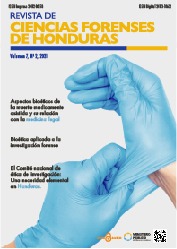Description of COVID-19 autopsy studies: a scoping review. November 2019 - December 2020.
DOI:
https://doi.org/10.5377/rcfh.v7i2.13171Keywords:
Autopsy, Post mortem changes, Incidental findings, Coronavirus infections, COVID-19Abstract
Background: Autopsies are essential to investigate emerging diseases because they contribute to the understanding of their pathophysiology and support their treatment. Objective: To describe the publications on autopsies of COVID-19 cases in the context of the pandemic, 2019-2020. Methodology: Scoping review. Period: November 2019-December 2020. Terms used: autopsy, post-mortem changes, incidental findings, Coronavirus infections in human subjects, in Spanish and English; in Research4Life, PubMed, LILACS, Researchgate. The PRISMA standard was used. The Research Scientific Unit, Faculty of Medical Sciences UNAH, approved the protocol. Results: From a total of 320 articles identified, 42 were selected, corresponding to 582 autopsies, all in the English language. Of the 42 articles, the two countries with the most publications were United States 16 and Germany 5. In 27, the range of reported autopsies was 1-10; in 17, the biosecurity measures implemented were not recorded and in 13, they were not specified. In 19, the size of the autopsy’s sample was not described. Complete autopsies were described in 14, complete and partial autopsies in 5 and partial autopsies in 4. In 11, the macroscopic findings were not described; in 42 the tissues were examined with a light microscope, in 28 immunohistochemical techniques were used, and in 7, electron microscope. The most studied organ was the lung in 40 studies. Conclusions and implications: More publications are needed reporting series of complete autopsy, resuming the importance of the study of all organs, and the determination of the causes of death from COVID-19. As of December 2020, no autopsy studies had been published in Latin America. The implications for case management and public policies demonstrate that investment should be made in autopsies, including histopathological studies that are required.
Downloads
638
PDF (Español (España)) 626
Published
How to Cite
Issue
Section
License
Copyright (c) 2022 Dra., Dra. , Dr.

This work is licensed under a Creative Commons Attribution-NonCommercial 4.0 International License.
El autor conserva los derechos de autor bajo los terminos de una licencia CC NC 4.0





